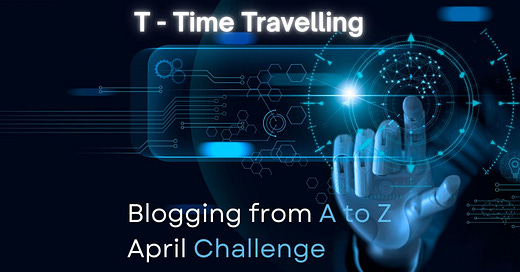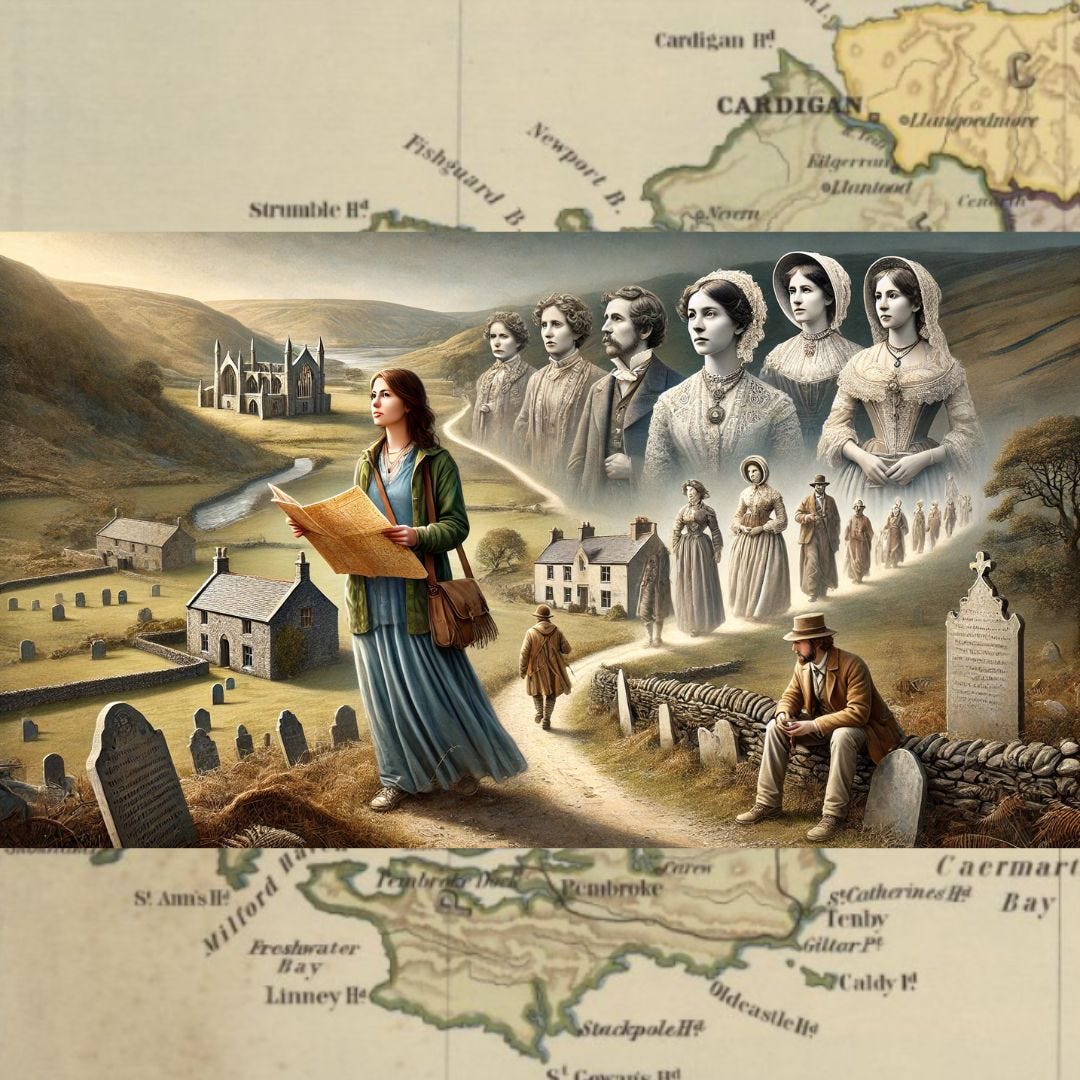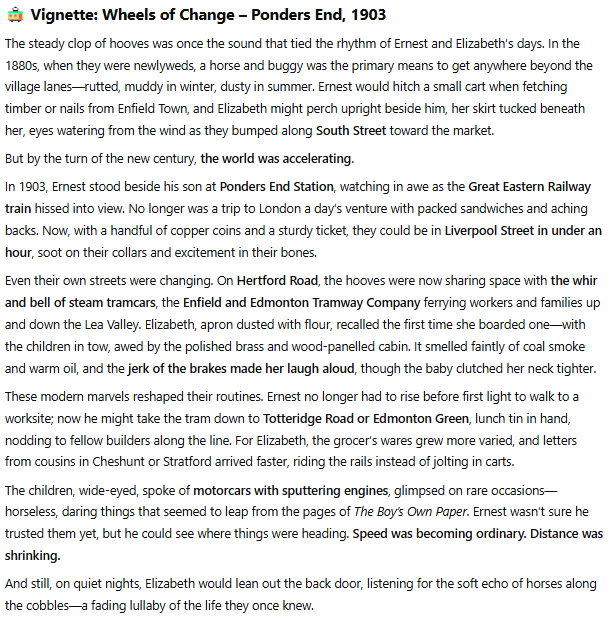Using AI to Walk Your Ancestors' Paths
Every genealogist has experienced that moment—staring at a faded photograph of an ancestor standing before their home, reading a description of the village they left behind, or examining a ship's manifest documenting their ocean crossing—when we wish we could step through time to witness their lives firsthand. While physical time travel remains the realm of science fiction, artificial intelligence is now creating remarkably close approximations, allowing us to virtually walk the paths our ancestors trod and experience aspects of their world that were previously left to imagination.
I wish I could walk in my Welsh ancestors' footsteps again. My ancestral trails would begin in Pembrokeshire with these towns and villages: Haverfordwest, Sutton, Treffgarne, Tenby, where my Evans family travelled. I would visit the places familiar to them 200 years ago and experience those same sights, smells, and sounds of rural life. What I would prefer is the ability to time travel and be in these places at the same time as they lived.
In this episode of the A to Z challenge, I will be discussing how ChatGPT, my chosen AI assistant for time travel, has helped me develop some ancestral trails for my English ancestors. You may recall the Goodall family and Edith Ann Robinson from previous episodes; I am continuing their stories by prompting ChatGPT to time travel with me.
Note: ChatGPT was selected for its ability to search the Internet for possible answers to my queries and prompts.
Beyond Names and Dates: Experiencing Ancestral Environments
Traditional genealogy has focused on documenting who our ancestors were through names, dates, relationships, and basic life events. But understanding how they lived—the sights they saw, the sounds they heard, the physical spaces they inhabited—requires a different kind of research. AI is now bridging this experiential gap through several groundbreaking approaches:
1. Environmental Reconstruction
AI can now generate detailed visual reconstructions of historical environments based on period descriptions, photographs, maps, and architectural knowledge:
Streetscape Recreation: Historical street views showing buildings, transportation, and daily activities as they would have appeared during your ancestors' time
Interior Visualization: Accurate depictions of typical home interiors based on socioeconomic status, location, and time period
Landscape Evolution: Visualizations showing how the natural environment changed over generations
These reconstructions allow us to literally "see" the world through our ancestors' eyes, providing context that mere descriptions cannot convey.
Case Study - Part 1: ChatGPT helps generate visual reconstructions
ChatGPT’s response for the specific area of Enfield, in England, in 1901 was incredibly useful to help guide my next research. I was able to uncover several rich resources that were relevant to the new urban development area of Enfield.
The most useful of these proved to be the Enfield Society publications, which provided me with photographs and incredibly detailed explanations of the historical photographs
I also perused the Francis Frith collection of photos of Enfield in this era to get a birds-eye view of the town, the streets, and the markets. All of these images are copyrighted and very expensive to buy. However, you too can view them online.
2. Sensory Immersion
Beyond visual reconstruction, AI is increasingly capable of recreating multisensory historical experiences:
Soundscape Generation: Recreating the ambient sounds of historical environments—from the industrial clamor of factory districts to the natural sounds of rural settings
Weather and Seasonal Patterns: Simulating typical weather conditions based on historical meteorological data
Daily Rhythm Modeling: Depicting how communities functioned throughout the day, from morning markets to evening activities
These sensory elements help researchers understand the lived experience of ancestors in ways that transcend visual information alone.
Case Study - Part 2: ChatGPT helps with sensory immersion
I wanted to find out more about the likely soundscape, weather patterns, and daily rhythms for Ponders End, where my ancestors migrated to during the building boom of the early 1900s.
ChatGPT provided a wonderful, sensory-filled opening segment for the piece about Ernest James Goodall. The names of the companies Rice and Son, Stockswell Builders, were extracted from the 1921 census record for Ernest. The names of the streets were extracted from the PDF documents from the Enfield Society. The context is provided by the descriptions of ‘a day in the life of’ as I requested.
Here is the second part of the story focussing on Elizabeth.
These will provide me with further elements of the story I am creating for Ernest James Goodall, ‘The Builder’s Legacy’. These responses from ChatGPT have been brilliant. They have a different style and flair from those of Claude, but have provided a new perspective for me in writing Ernest’s story with visual and sensory adaptations of scenes and subplots.
This process enables me to virtually walk the paths my ancestors trod and experience aspects of their world that were previously left to imagination.
3. Journey Mapping
Perhaps most compelling for migration histories, AI can now recreate historical journeys with remarkable fidelity:
Route Visualization: Mapping ancestral journeys using historical transportation networks rather than modern roadways
Travel Condition Simulation: Recreating the experience of traveling by ship, train, wagon, or foot during specific historical periods
Chronological Accuracy: Calculating realistic timeframes for historical journeys based on period-appropriate transportation methods
These tools transform abstract lines on maps into comprehensible human experiences, helping us appreciate the magnitude of our ancestors' journeys.
Case Study - Part 3: ChatGPT helps map the journey of my ancestors
My next prompt for ChatGPT was engineered to dig deeper into the history of transportation for my ancestors in the 1890s and early 1900s. From my research into the Goodall family movements in the north of England, through census records, I wanted to focus on the type of transport they would have used.
Amazing creative narrative from ChatGPT, I am impressed and now considering using ChatGPT a little more for my creative writing. (Note to self: I need to add this example to my video tutorials in my YouTube Playlist ‘Genealogy AI Face Off: Claude takes on ChatGPT’.)
Practical Applications for Family Historians
How can genealogists leverage these AI time travel capabilities in their research and storytelling?
1. Research Enhancement
Virtual environmental experiences can dramatically improve research effectiveness:
Contextual Understanding: Better comprehending why ancestors made certain decisions based on their physical environment
Record Interpretation: More accurately interpreting historical documents by understanding their physical and cultural context
Research Planning: Identifying potential record sources based on visual reconstructions of communities
2. Family History Presentation
AI-generated experiences create powerful new ways to share family history:
Interactive Family Narratives: Creating explorable environments that bring written family histories to life
Virtual Family History Tours: Guiding relatives through ancestral locations as they appeared during different eras
Comparative Time-lapse Experiences: Showing how ancestral environments evolved across generations
3. Educational Outreach
These tools offer unique educational opportunities:
Intergenerational Engagement: Creating experiences that help younger generations connect with family history
Community History Projects: Developing shared virtual environments that show how communities evolved
Cultural Preservation: Documenting and recreating environments that have been significantly altered or lost
Ethical Considerations
Time travel experiences, while powerful, require thoughtful ethical engagement:
Accuracy vs. Speculation: Clearly distinguishing between elements based on historical documentation and those requiring creative interpretation
Cultural Sensitivity: Ensuring representations of ancestral communities respect cultural nuances and avoid stereotypes
Multiple Perspectives: Acknowledging that different community members experienced historical environments differently
Technology Access: Considering how to make these experiences accessible to family members with varying levels of technological comfort
Looking Forward: The Future of AI Time Travel
As AI technology continues to evolve, we may anticipate several exciting developments. These seem to be the stuff of science fiction, but you may be able to find elements of these happening right now.
Personalized Environments: Creating experiences tailored to specific ancestral characteristics like occupation, social status, and family structure
eg AI tools like ChatGPT and Claude can already do this for you with careful prompt engineering.Interactive Historical Figures: Simulating conversations with historical community members based on period-appropriate language and knowledge
eg AI tools like ElevenLabs can help ‘create the most realistic speech with their AI audio platform’Collaborative Exploration: Enabling multiple family members to simultaneously explore ancestral environments together.
eg The WeAre.xyz family history archiving platform enables you to share family trees, ancestral trails, occasions, stories, artefacts, maps, places, blogs, and more with your family members. Visit the story of ‘The Builder’s Legacy: Ernest James Goodall’s Craft and Heritage’ in my family archive here; it is a work in progress.Sensory Expansion: Adding more refined sensory elements like touch feedback and even scent simulation
Note: I don’t have any examples of that right now! Do you?
Summary: A Bridge Across Time
While physical time travel remains impossible, AI-powered virtual experiences now offer genealogists an unprecedented opportunity to walk in their ancestors' footsteps, see through their eyes, and develop deeper emotional connections to their lives and experiences. These technologies transform genealogy from a primarily intellectual pursuit into an emotionally immersive journey, helping us not just know who our ancestors were, but experience aspects of how they lived.
The most powerful application combines AI's technical capabilities with the genealogist's personal connection and historical knowledge. Together, they create time travel experiences that honor our ancestors' stories while making them accessible and meaningful to current and future generations.
As you explore these emerging tools, consider how they might help you not just document your family's past, but experience it in ways that build deeper understanding and connection, truly walking the paths your ancestors walked, if only virtually.
Ready to elevate your genealogy research with AI? Come and learn how to become an AI-skilled ancestral storyteller in the course, "Beyond the Pen: Using AI to Transform Ancestral Storytelling." Discover practical techniques and ethical approaches to incorporating AI into your family history work. Join us at Beyond the Pen and transform how you preserve your family's legacy!
Have you used any AI tools to visualize or experience your ancestors' environments? What aspects of their lives would you most like to experience through virtual time travel? Share your thoughts in the comments below!


















Thank you so much Carole for providing so much information. I know for me that your information is going to make it so much easier to build a story of the life of my ancestors. I hadn't thought of asking for a streetscape. I will definitely be asking for a look at the street of my ancestors in Haverfordwest.
You always amaze me Carole and give me more ideas to improve my family history stories.